When it comes to house chores, there is no way you can’t get away with dirty laundry. Not unless you can live without clothes and anything that requires some washing. Since you don’t want to spend your precious time and energy on hand-washing, the best solution is a washing machine! However, buying a washing machine is easier said than done.
There are tons of brands that sell washing machines in physical stores and online shops. To make the list even longer and more intimidating, each brand also offers different models. So, the question now is, how are you going to choose the right one that fits your needs?
To make it easier for you to decide and narrow down your search, we prepared this guide with the important things you need to consider. If you want a list curated by experts, you may check this list.
- Types
Washing machines can be categorized into 3 main types which include the top load agitator, top load impeller and front load.
o  Front-load – this is one of the most common washing machines nowadays in households and laundry shops. It has its lid in front and depends on its washing power in speed so clothes can rub against each other. Still, it is gentle on clothes to prevent them from being ripped apart while inside. Aside from accommodating large items like comforters and even sleeping bags, it doesn’t consume a lot of water and energy too.
Furthermore, it is built with advanced control panels that control its sensor and automatic functions. But even if it operates without noise, its cycle times are about 2 minutes longer than top loads. It also struggles with filthy stinky clothes despite its advanced settings.
o  Top load agitator – this is a traditional type of washing machine that is still common in many households for decades. This has its lid on top and a long agitator inside, right in the middle of the tub. The agitator is its main feature where clothes swish against once activated. It is also the least expensive type that gets the job done just in time.
However, it can be a little harsh on clothes, especially those with delicate fabrics. It’s also hard to fit large items like multiple blankets and comforters since its long agitator stands in the middle. Lastly, it consumes a lot of water and energy.
o  Top load impeller – this is also called a “high-efficiency†and the newest type of washing machine. It looks like any top load washing machine minus the agitator in the middle. Instead, it has an impeller at the bottom of the tub to swoosh clothes back and forth. The tub itself moves to reinforce the impeller in washing.
Some models would even allow you to fill them with water to the top if necessary to guarantee your clothes’ cleanliness. To save energy, you can activate its high-efficiency cycle option for almost all types of loads.Â
- Â Â Â Â Size and Space
Normally, an average washing machine has 27 inches width and requires 6+ inches clearance behind for venting and hookups. Those models with bigger capacities are usually 2 to 3 inches wider which applies with dryers too. Regardless, note your doors’ measurement and the dimension of the washing machine to make sure that it can fit through. If you’re stuck with a tight space, choose a compact washing machine.Â
- Â Â Â Â Noise and Vibration
Noise and vibration are two factors that you shouldn’t forget when it comes to washing machines. Quiet machines should have a high or “very good†score in noise tests to avoid disturbing anyone in the vicinity. Take note of its vibration score as well, especially if you prefer a full-sized washing machine. This can keep you out of trouble if you live in an apartment building or condominium. Â
- Â Â Â Â Capacity
We already mentioned a bit of information about each type’s capacity but we’ll elaborate here. If you have a big family, you might find compact units inadequate. If you want to fit at least 16 thick and full-sized bath towels in one cycle, your unit should have at least 6.2 cu ft. capacity. Smaller and compact units with 2.3 cu ft. capacity can usually fit 6 thick towels only since we don’t recommend overloading.Â
- Â Â Â Â Energy Efficiency
This is one of the features that you should check if you want to save in the long run. Most high-efficiency models nowadays also display an EU Energy Rating label with “A+++†as the highest score. Though the style of rating may differ on each brand, always choose the one with the best score. Look for its kWh/year and L/year details too.Â
Conclusion
Depending on the mentioned factors above, brand, and additional features that you prefer, the price of washing machines varies. The more features you need the higher the amount you’re likely to pay. For instance, some costs 20000 Rs or less while others cost 1Lakh or more. The important thing is, it should be able to provide your needs, fit your budget, and last for years. Don’t forget to check its warranty period and return policy as well.Â
